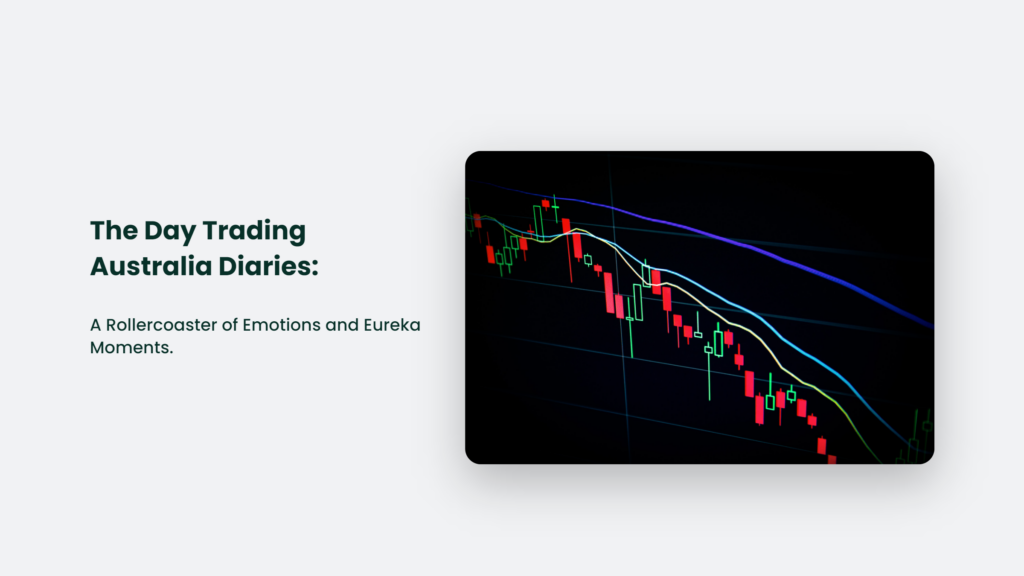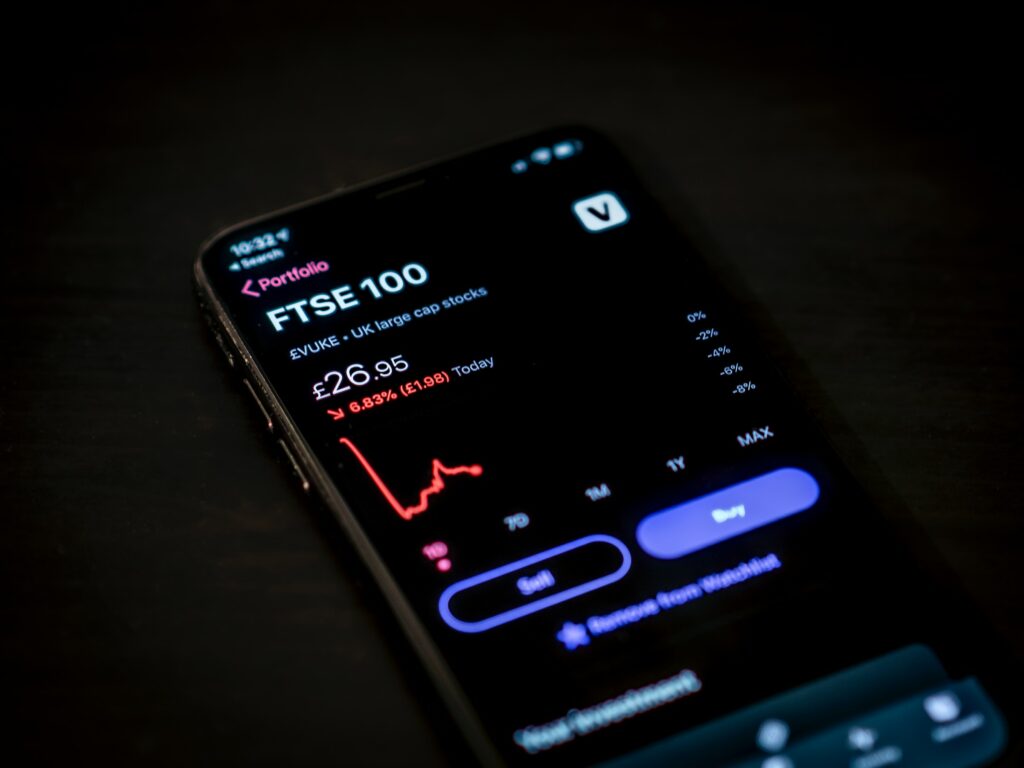

The Day Trading Australia Diaries: A Rollercoaster of Emotions and Eureka Moments.

As Seen On
Disclaimer: This blog is for educational purposes only and not financial advice. Before making investment decisions, consult a qualified financial advisor. The author and publisher are not responsible for any losses or damages resulting from the use of this information.
Picture this: It’s a beautiful morning in Sydney. The sun is just peeking over the horizon as you sit down at your computer, armed with a strong cup of coffee and a steely determination to conquer the world of day trading Australia. You’re about to embark on an epic journey filled with adrenaline-pumping highs, gut-wrenching lows, and more than a few hearty chuckles. Buckle up, my friend, because today we’re diving into the wild and wonderful world of day trading Down Under.

Table of Contents
The Kangaroo Chronicles – A Tale of Two Traders
Let me tell you a thrilling tale of two traders – or as I like to call them, the Kangaroo and the Wallaby. With his powerful legs and unwavering focus, the Kangaroo represents the savvy day trader who has honed his skills and developed a killer instinct for sniffing out lucrative opportunities.
The Wallaby, on the other hand, is the jittery novice, hopping from trade to trade without a clear plan and ultimately finding himself lost in the outback of financial ruin.
This tale begins with the Kangaroo, who has just discovered the hidden treasure trove that is day trading in Australia. Meanwhile, the Wallaby watches in awe and decides to jump into the fray, dreaming of the riches that await him.”Crikey,” he exclaims, “I’ve struck gold!”
But here’s the twist: The Wallaby doesn’t have a clue about what he’s doing. He’s the kind of guy who hears “stop-loss order” and thinks it’s a command to cease buying takeout. So, what happens to our beloved marsupial heroes? (Spoiler alert: It’s a wild ride.) well, you’ll have to keep reading to find out.
The Land of Opportunity – Why Day Trading Australia is All the Rage
If there’s one thing Aussies love, it’s a good underdog story. And day trading in Australia offers the chance for the little guy to make it big in the cutthroat world of finance.
But why exactly is this market so enticing for traders worldwide? Let’s break it down with some cold, hard facts and fiery metaphors.
A Market of Mammoth Proportions:
Australia boasts one of the world’s largest and most diverse stock markets, with over 2,000 publicly-listed companies. It’s like a never-ending buffet of financial opportunities, where you can gorge on everything from blue-chip behemoths to scrappy start-ups.
The Land Down Under:
No, I’m not talking about Men at Work’s catchy 80s tune (although it’s a classic). In Australia, the market opens several hours before other major markets like the US and Europe, giving day traders a head start on the action. Picture yourself as a surfer catching the first wave of the day while your competitors snooze in their beach shacks.
A Regulatory Rock Star:
The Australian Securities and Investments Commission (ASIC) is like the Mick Jagger of financial regulators – it’s got the moves (and the authority) to keep the market in check and maintain a high level of investor confidence. In other words, it’s a rock-solid environment for day traders to strut their stuff.
The Art of Day Trading – Strategies, Tips, and Tricks for Outback Dominance
Now that you’re chomping at the bit to dive into day trading in Australia, it’s time to learn the tools of the trade. And trust me, this isn’t like trying to assemble IKEA furniture – it’s more like learning to wield a razor-sharp boomerang that’ll make you a formidable force in the market.
The Chart Whisperer:
Just as Captain Cook navigated uncharted waters during his voyages, successful day traders must also learn to chart their course through the complex world of financial markets.
One indispensable skill for any aspiring day trader is the ability to read and interpret candlestick charts. These charts visually represent price movements, allowing traders to spot patterns that signal potential profit opportunities.
To become a chart whisperer, you’ll need to familiarize yourself with some key concepts:
- Candlesticks: These visual representations show the opening, closing, and high and low prices for a specific period. A green (or white) candlestick indicates that the closing price is higher than the opening price, while a red (or black) candlestick signifies a lower closing price.
- Support and Resistance Levels: These are price points at which a stock tends to stop and reverse direction. Support levels act as a floor, preventing the price from dropping further, while resistance levels act as a ceiling, stopping the price from rising higher. Identifying these levels can help traders determine entry and exit points for their trades.
- Trend Lines: These lines connect a series of highs or lows on a chart, indicating the overall direction of the market (upward, downward, or sideways). By drawing trend lines, traders can identify potential breakouts and reversals.
- Technical Indicators: These mathematical calculations help traders assess price movements’ strength, direction, and momentum. Some popular indicators include moving averages, Relative Strength Index (RSI), and Bollinger Bands.
By mastering the art of chart reading, you’ll be able to navigate the high seas of financial opportunity with confidence, skill, and precision.
The Tactical Toolbox: Exploring the Wide World of Trading Strategies
There’s no one-size-fits-all approach to day trading, so exploring and experimenting with different strategies to find the one that suits your personality and risk tolerance is essential. Here’s a deeper dive into some popular day trading techniques:
- Scalping: This high-speed trading strategy involves making multiple small daily trades, capitalizing on minor price fluctuations. Successful scalpers must be quick on their feet, possess excellent risk management skills, and maintain strict discipline.
- Momentum Trading: Momentum traders ride the wave of strong price movements, buying into stocks trending upward and selling when they lose momentum. This strategy requires keen market analysis, a solid understanding of technical indicators, and the ability to act quickly.
- Swing Trading: Swing traders seek to capitalize on short-term price swings, typically holding positions for several days to weeks. This strategy involves a combination of technical and fundamental analysis and a keen understanding of market sentiment.
- Mean Reversion: Mean reversion traders bet that stock prices will eventually revert to their historical averages. They identify overbought or oversold stocks and take positions accordingly, anticipating a return to normalcy. This strategy requires patience and a strong understanding of statistical analysis.

The Emotional Ninja: Cultivating a Zen-Like Mindset for Day Trading Success
Day trading can be an emotional rollercoaster, with the potential for significant gains and losses in a short period. It’s essential to cultivate a calm, focused mindset to weather the storm of market volatility. Here are some tips for becoming an emotional ninja:
- Develop a Trading Plan: A well-defined trading plan serves as a roadmap for your day trading journey, helping you make informed decisions and avoid impulsive actions driven by fear or greed.
- Practice Mindfulness: Regular meditation and mindfulness practices can help improve focus, reduce stress, and promote emotional stability. By cultivating present-moment awareness, you’ll be better equipped to handle the emotional ups and downs of day trading.
- Set Realistic Expectations: It’s crucial to approach day trading with a realistic outlook. Understand that losses are a part of the game, and not every trade will be a winner. By managing your expectations, you’ll be less likely to experience extreme emotional swings based on your trading performance.
- Embrace Discipline and Patience: Successful day traders exercise discipline in sticking to their trading plan and demonstrate patience by waiting for the right opportunities to present themselves. By developing these qualities, you’ll be less likely to make impulsive decisions based on emotional reactions.
- Learn from Your Mistakes: Instead of dwelling on losses or beating yourself up over mistakes, view them as valuable learning experiences. Reflect on what went wrong and identify areas for improvement. This growth mindset will help you become a more resilient and adaptable trader.
By cultivating a zen-like mindset, you can navigate the turbulent waters of day trading with grace and composure, increasing your chances of success in the long run.
But enough with the metaphors – let’s dive into some real-life examples of how these strategies can play out in the wild world of day trading Australia.
Example 1: The Hare and the Tortoise – A Tale of Scalping
Remember Aesop’s fable about the hare and the tortoise? In the world of day trading, scalpers are the hares – they’re lightning-fast, swooping in to snatch up small profits from rapid market movements.
Our friend, the Kangaroo, is a natural-born scalper with keen instincts and nimble fingers. He spots a fleeting opportunity in the ASX and pounces, reaping a quick reward before the Wallaby can even blink.
Example 2: Riding the Wave – A Story of Momentum Trading
Surf’s up, dude! In this example, we’re hitting the waves with momentum trading, a strategy that involves riding the crest of a stock’s strong upward or downward trend. The Kangaroo expertly catches the wave, using his knowledge of technical indicators to identify the perfect entry and exit points. The Wallaby, however, wipes out, mistiming his moves and ending up in the metaphorical financial undertow.
The Moral of These Stories? Education, practice, and a solid strategy are the keys to day trading success in Australia. And while the Wallaby may have stumbled, there’s still hope for him yet – if he’s willing to learn from the Kangaroo’s sage wisdom.

A Word of Warning – The Dark Side of Day Trading Australia: Unveiling the Hidden Dangers
Venturing into the world of day trading can be an exhilarating journey, filled with the promise of financial rewards and the thrill of the chase. However, it’s essential to recognize and understand the darker side of day trading before embarking on this adventure.
Just as venturing into the Australian outback without a map or a trusty kangaroo companion can be dangerous, so too can diving headfirst into day trading without proper preparation and awareness.
High Levels of Risk:
One of the most significant challenges day traders face is the inherently high level of risk associated with short-term trading. With the potential for rapid price fluctuations, even the most experienced traders can face substantial losses. Developing and adhering to a well-defined risk Financial Losses: The stark reality is that most day traders do not achieve long-term success, and many lose money. It’s essential to approach day trading with realistic expectations and be prepared for possible financial loss. A strong focus on education, skill development, and continuous improvement can help increase your chances of success. Day trading can be an emotional rollercoaster, with traders experiencing the highs of winning trades and the crushing lows of losing ones. This emotional turmoil can lead to stress, anxiety, and even depression, taking a toll on your mental well-being. Developing healthy coping mechanisms and maintaining a balanced lifestyle is critical for navigating the emotional challenges of day trading. The fast-paced nature of day trading and the potential for significant financial gains can create a potent cocktail that leads some traders toward addiction. It’s essential to recognize the signs of trading addiction – such as an obsession with the markets, neglecting personal relationships, and engaging in reckless trading – and seek help if necessary. The intense focus and constant decision-making required for day trading can lead to exhaustion and burnout. Balancing your trading activities and personal life is essential, ensuring you take regular breaks and practice self-care to maintain your overall well-being. Day trading can be a solitary pursuit, with many traders spending long hours alone in front of their screens. This isolation can lead to feelings of loneliness and disconnection from friends, family, and the wider community. It’s essential to make an effort to maintain social connections and engage in activities outside of trading to promote a balanced and fulfilling life. While day trading can be an exciting and potentially lucrative endeavour, it’s essential to be aware of the dark side and the dangers that lurk beneath the surface. By understanding these challenges and taking steps to mitigate them, you can better equip yourself to navigate the unpredictable world of day trading and increase your chances of success. No, you don’t need a specific license to day trade. However, you do need to open a trading account with a brokerage firm that is regulated by ASIC. There’s no one-size-fits-all answer to this question, as it depends on your individual financial situation and risk tolerance. However, many experts suggest starting with a minimum of $5,000 to $10,000 to give yourself a buffer for potential losses and to cover trading costs, such as commissions and fees. The potential earnings from day trading can vary wildly, and there’s no guarantee of profit. Some traders may earn a comfortable living, while others may struggle to break even. It’s essential to approach day trading with realistic expectations and a commitment to learning and improving your skills. Day trading profits are generally treated as ordinary income and subject to income tax. However, specific tax rules and regulations can vary depending on your individual circumstances. It’s always a good idea to consult a tax professional for advice tailored to your situation. Yes, it’s possible to day trade part-time while maintaining a full-time job. However, it can be challenging to balance the demands of both, and you may find that your trading performance suffers as a result. Be prepared to make some sacrifices and dedicate the necessary time and energy to become a successful part-time trader. There are several excellent platforms for day trading in Australia, including Interactive Brokers, IG, CMC Markets, and Plus500. It’s crucial to research and compare these platforms to find the one that best suits your needs and preferences. And so, our journey through the wilds of day trading Australia ends. But for you, brave trader, this is just the beginning. With the wisdom of the Kangaroo by your side and the boundless opportunities of the Australian market at your fingertips, you’re ready to forge your path to day trading glory. So, what are you waiting for? Grab your boomerang, throw on your Akubra, and join the ranks of the elite day traders who call the Land Down Under their financial playground. And when you’re basking in the glow of your hard-won success, don’t forget to raise a toast to the Kangaroo – and maybe spare a thought for the Wallaby, too. Good luck, and happy trading!Emotional Turmoil:
Addiction:
Burnout:
Isolation:
Frequently Asked Questions:
Do I need a license to day trade in Australia?
How much money do I need to start day trading?
How much can I realistically make from day trading?
What are the tax implications of day trading in Australia?
Can I day trade part-time while keeping my day job?
What are the best platforms for day trading in Australia?
The Final Frontier – Embarking on Your Day Trading Adventure
Konger
Up until working with Casey, we had only had poor to mediocre experiences outsourcing work to agencies. Casey & the team at CJ&CO are the exception to the rule.
Communication was beyond great, his understanding of our vision was phenomenal, and instead of needing babysitting like the other agencies we worked with, he was not only completely dependable but also gave us sound suggestions on how to get better results, at the risk of us not needing him for the initial job we requested (absolute gem).
This has truly been the first time we worked with someone outside of our business that quickly grasped our vision, and that I could completely forget about and would still deliver above expectations.
I honestly can't wait to work in many more projects together!
Disclaimer
*The information this blog provides is for general informational purposes only and is not intended as financial or professional advice. The information may not reflect current developments and may be changed or updated without notice. Any opinions expressed on this blog are the author’s own and do not necessarily reflect the views of the author’s employer or any other organization. You should not act or rely on any information contained in this blog without first seeking the advice of a professional. No representation or warranty, express or implied, is made as to the accuracy or completeness of the information contained in this blog. The author and affiliated parties assume no liability for any errors or omissions.

